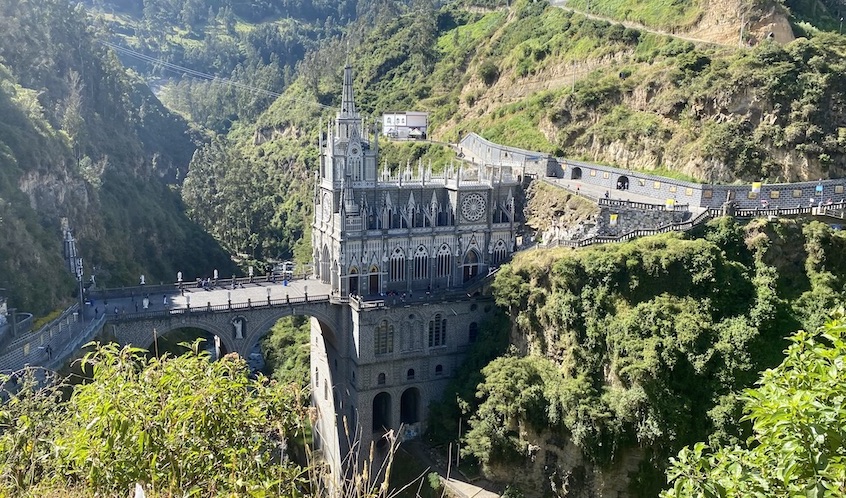
Las Lajas shrine, as seen from a walking trail above. Photo by Teresa Bergen
By Teresa Bergen
Vendors selling rosaries and huge striped lollipops line the steep hill down to Las Lajas, Colombia’s most important religious shrine. You can get your picture taken with a nonplussed llama wearing a sequined pink hat or pay local carvers to engrave a plaque thanking the Virgin Mary for favors. Is this a pilgrimage or is it a fiesta? In Colombia, it seems that you can have both.
I’d chosen to go on a small group trip through the Pasto region of southern Colombia because I love Catholic religious shrines, and because I’d never heard of Pasto, an Andean city of a half million. While cities like Bogota, Medellin and Cartagena are famous, Pasto is less visited by foreigners. Its many churches give it the nickname “the theological city.” It’s also known as “the surprise city,” since apparently I’m not the only one who didn’t know what to expect.
Officially called San Juan de Pasto, the city was founded in 1537 by a Spanish conquistador. At nearly 9,000 feet in elevation, it’s cooler than much of Colombia, with temperatures staying close to an average of 60 degrees. Galeras, one of Colombia’s most active volcanoes, looms over the city. Pasto is the capital of the department of Nariño. Is it worth the time and money to visit Pasto when Colombia has so much more to offer? I spent three days touring Nariño to find out.
The safety question
Before detailing Pasto attractions, let’s address the safety question. Before I left on my journey I spoke with a representative of the Colombian government. She said it was unlikely I’d be kidnaped while in Pasto. This did not have the desired effect. In the weeks prior to my departure, I worried about kidnapping, drug cartels and political unrest. Colombians had just elected Gustavo Petro, the first president whose previous jobs included being an ex-guerilla fighter.
During my four days in Bogota and three in Nariño, Colombians constantly reminded me not to go out alone. At the same time, I saw nothing very scary, especially around Pasto, where we had nearly constant police escorts.
The Pasto police were extremely friendly. Our main police escort, Alejandro, had an international education, having grown up partly in Israel speaking Hebrew and English. He told me that Pasto was a favorite posting for police, as it was much safer to be an officer in Pasto than in many of Colombia’s big cities.
Our guide, Laura Gaviria, told us that all tour groups to Colombia get police escorts, but individuals are on their own. One day she excitedly pointed out a rare Euro-looking tourist walking down the street in Pasto. “See!” she said, proudly proving her point. “No police!” I found it very hard to get a handle on the true safety picture.
Carnival Museum
Pasto is best known for its annual Black and White Carnival, with events running from late December through early January. It’s a huge deal for the city and attracts tourists from all over the world. In 2009, UNESCO added Carnaval de Negros y Blancos to its list of the intangible cultural heritage of humanity.
The first stop on my itinerary was the Carnival Museum. Those entering the museum are greeted by neon-bright cartoon characters who tower above visiting humans. The sculptures used on past floats depict animals, skeletons and fanciful humanoids. Lions and demons represent the spirit of the nearby volcano.
Guinea pigs are a particularly popular theme in Pasto. Like other Andean places, they are farmed for food. But they also are celebrated in statues and ubiquitous figurines sold to tourists. My favorite statue in the Carnival Museum was a ten-foot-tall guinea pig wearing a rainbow-feathered lion headdress and playing a panpipe.
Like other Carnival celebrations, music, dancing and debauchery rein. “In Carnival there is no time for bad news,” Laura explained. “Everybody is dancing and playing.” But Pasto’s carnival keeps on a tight schedule. Each day has a particular focus, whether it’s children’s day, family day, black day or white day. The Carnival of Water starts it off with water fights similar to those occurring in Thailand during Songkran. On New Year’s Eve, marchers carry satirical figures representing current events, ending with a ritual burning to signify the end of the old year. Black day commemorates the liberation of Colombia’s slaves. Everybody is black for the day. “You are going to be painted with black paint,” Laura said, explaining that if you are a tourist, at first people might ask if you want to be painted. But when they gain confidence, they just go for it, painting your face and other exposed skin, and even pulling up strangers’ shirts and painting their stomachs black. On white day, everybody paints each other with white powder. This custom is meant to express a mutual desire for tolerance and respect.
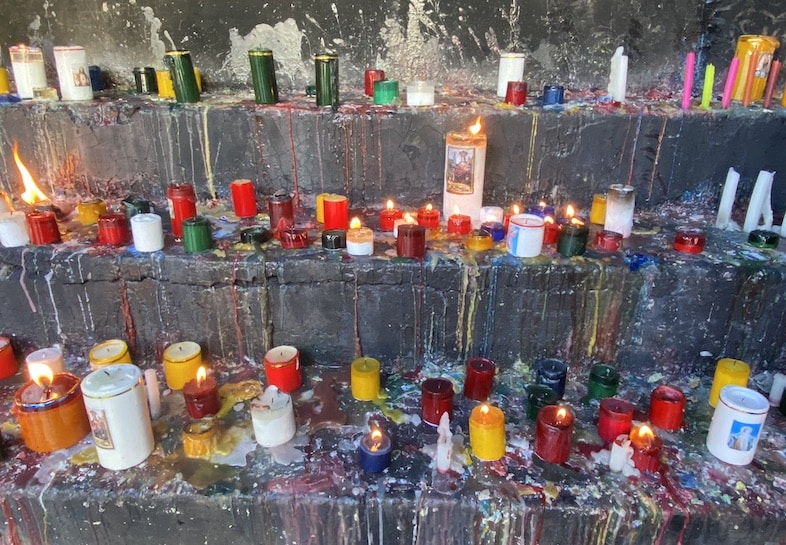
Candles lit by the faithful at Las Lajas. Photo by Teresa Bergen
Visiting Las Lajas
The Las Lajas shrine near the town of Ipiales is very close to Colombia’s border with Ecuador. It’s an important pilgrimage spot for Catholics in the region. Back in 1754, Maria Mueses de Quinones saw an apparition of the Virgin Mary in a cave where she sheltered during a storm. A miraculous and brightly colored image, now known as Our Lady of Las Lajas, appeared and remained permanently on the cave wall. After seeing an apparition of Mary, Maria’s deaf-mute daughter started to speak. A local priest regained his eyesight after kneeling before the image.
For both our Colombian guides, Laura Gaviria and Eduardo Saldaña, Las Lajas was a staple of their growing-up years. Laura’s family lived a few hours away but made the pilgrimage at least annually. Eduardo’s mother took him to Las Lajas twice a month. I calculated he’d been there at least 360 times over the course of his life. One of the engraved stone tablets, or ex-votos, that line the path to the shrine expresses his mother’s gratitude for being blessed with her family.
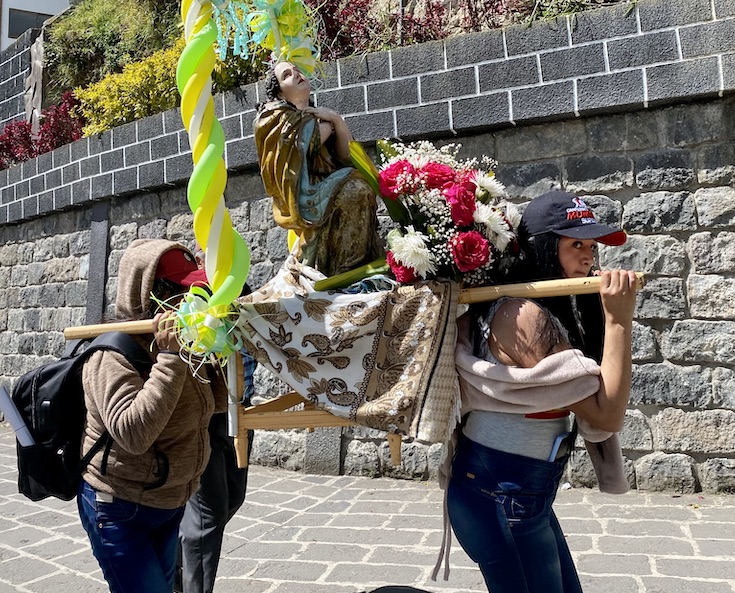
Pilgrims carry an image of Mary to Las Lajas. Photo by Teresa Bergen
The shrine is at the bottom of a huge, spectacular canyon. It’s gone through various iterations over the centuries, but its current look is gorgeous gothic with lots of spires. The church is full of people praying and posing for pictures. It has a fabulous set of stained-glass windows, all depicting apparitions of Mary from around the world. The shrine complex also includes a museum, snack vendors, souvenir stands and pathways leading to viewpoints. I braved the elevation to walk up a big hill to a statue of the Archangel Michael slaying the devil. On the way, I found the perfect souvenirs for my Catholic family: little guinea pig figurines dressed as nuns and priests.
Tulcan Cemetery
Just across the border of Ecuador, the town of Tulcan has a cemetery that’s known for its topiaries. Our tour bus had to wait a few minutes at the border, but it was an easy crossing and nobody even asked to see our passports. A few minutes later, we glimpsed the dense green topiaries and white banks of mausoleums.
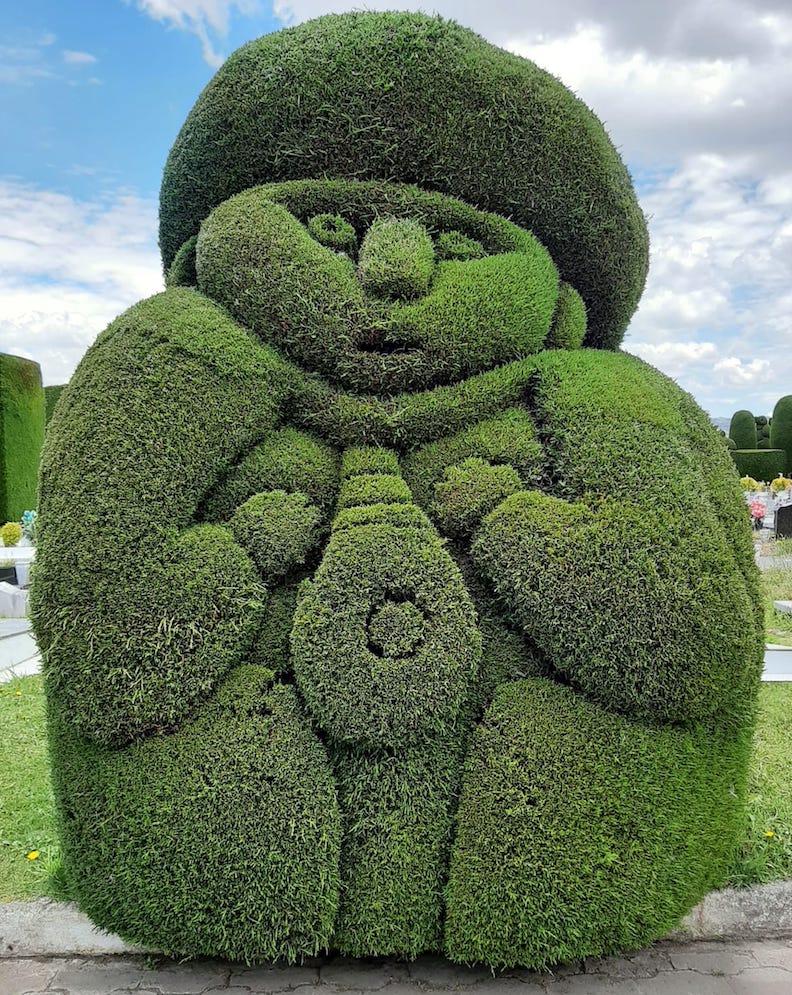
One of the many impressive topiaries at Tulcan Cemetery in Ecuador. Photo by Teresa Bergen
This wonder dates back to 1936 when gardener and cemetery caretaker Josè Maria Azael Franco got creative with his sheers. He sculpted bushes into archways, geometric shapes, Incan symbols, angels and various creatures. Satisfied with his work, he deemed Tulcan Municipal Cemetery “so beautiful it invites one to die.” Franco died in 1985 and now rests in the cemetery. His five sons continued his work.
The graves and mausoleums are also fun to visit, as they are colorful and highly personalized to reflect the lives of occupants. One of my favorites was a giant private mausoleum owned by a family that made their money in the tire business that was decorated with sculpted tires incorporated into the design.
Lots of local people come for photo ops and there’s more of a party atmosphere than you’ll find in your typical cemetery. The freshly clipped topiaries imbue the cemetery with a wonderful tree scent.
Laguna de la Cocha
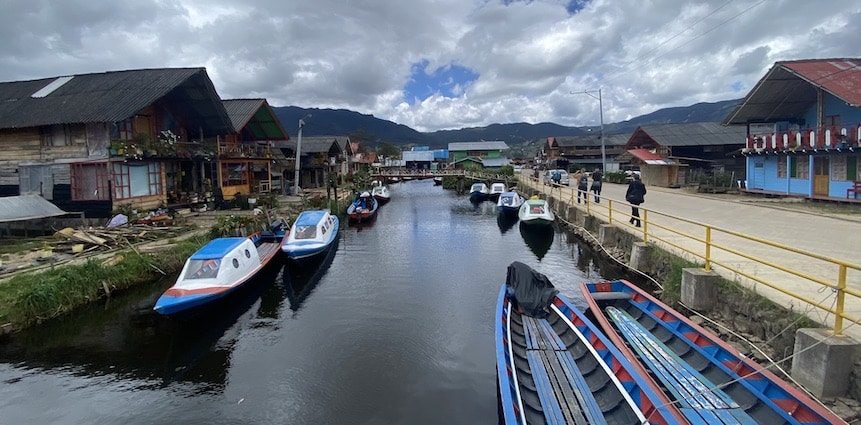
Tourists hire these boats to take them from the canal into La Cocha Lagoon, sometimes stopping at a wildlife sanctuary. Photo by Teresa Bergen
Laguna de la Cocha is one of Nariño’s biggest tourist attractions. Central to the attraction is La Cocha Lagoon, a volcanic crater lake that is Colombia’s second-largest inland body of water. A cute but weird tourist village called El Puerto is built around the lagoon. Tourists board long, skinny boats in a canal for sightseeing cruises. Chalet-style shops and restaurants line both sides of the canal, including the Camino del Viento café, where owner Juan Pablo Chamorro gave us a coffee talk.
“Last year Nariño produced the best coffee in the world,” Chamorro insisted, explaining that the confluence of Andean and Amazonian climates does something special for the beans. We brewed our own cups at our tables, using small wooden stands that held reusable linen filters, dripping coffee into the traditional metal mugs used by farmers.
We stopped by a nearby organic family farm called San Francisco, which has gotten into small-scale agritourism. The Jojoa family leads visitors on a short farm tour complete with crops, ducks, friendly dogs and big smelly pigs. The tour ends with snacks and coffee, tea or chicha—the traditional fermented drink of the Andes—in the farm kitchen.
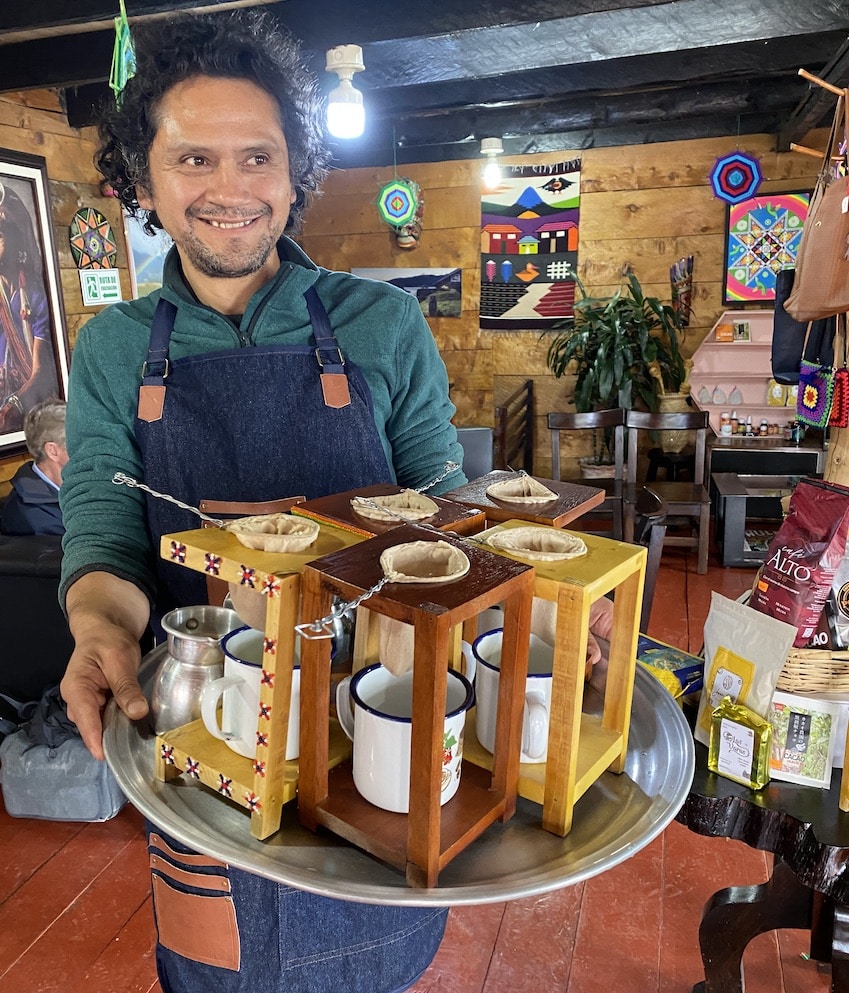
Juan Pablo Chamorro, owner of Camino del Viento café, bearing a tray of individual drip coffee devices. Photo by Teresa Bergen
Black Christmas in Pasto
In between trips around Nariño, we had some time to acquire a more nuanced understanding of Pasto. Historically, it has always been a city of rebels, but not in the expected South American sense. Pasto thrived in its colonial relationship with Spain and didn’t want independence. Residents fought revolutionary Simón Bolívar’s troops with sticks and machetes, the only weapons they had.
On Christmas Eve, 1822, now remembered as Black Christmas, Simon Bolívar ordered the citizens slaughtered. In a letter he wrote in 1822, Bolívar tried to excuse his barbarity. “Because you must know that the Pastusos are the most demonic devils that have ever come out of hell,” he wrote. “The Pastusos must be annihilated and their women and children transported elsewhere, giving that country to a military colony, otherwise Colombia will remember the Pastusos when there is the slightest commotion, even if it is a hundred years from now, because they will never forget our ravages, even if they are too well deserved.”
It’s been 200 years, but to Pastusos it might as well be last year. A three-day spree left hundreds of people murdered, many in churches, women and children raped, homes robbed and public archives destroyed.
So as I watched a teenage girl kneeling for a quick afternoon prayer in an old church, her dog flopped by her side, I imagined the corpses strewn about this same church 200 years ago. And while visiting the bustling public market—more guinea pig souvenirs—and trying ice cream made in traditional copper bowls, I imagined the streets running red with blood.
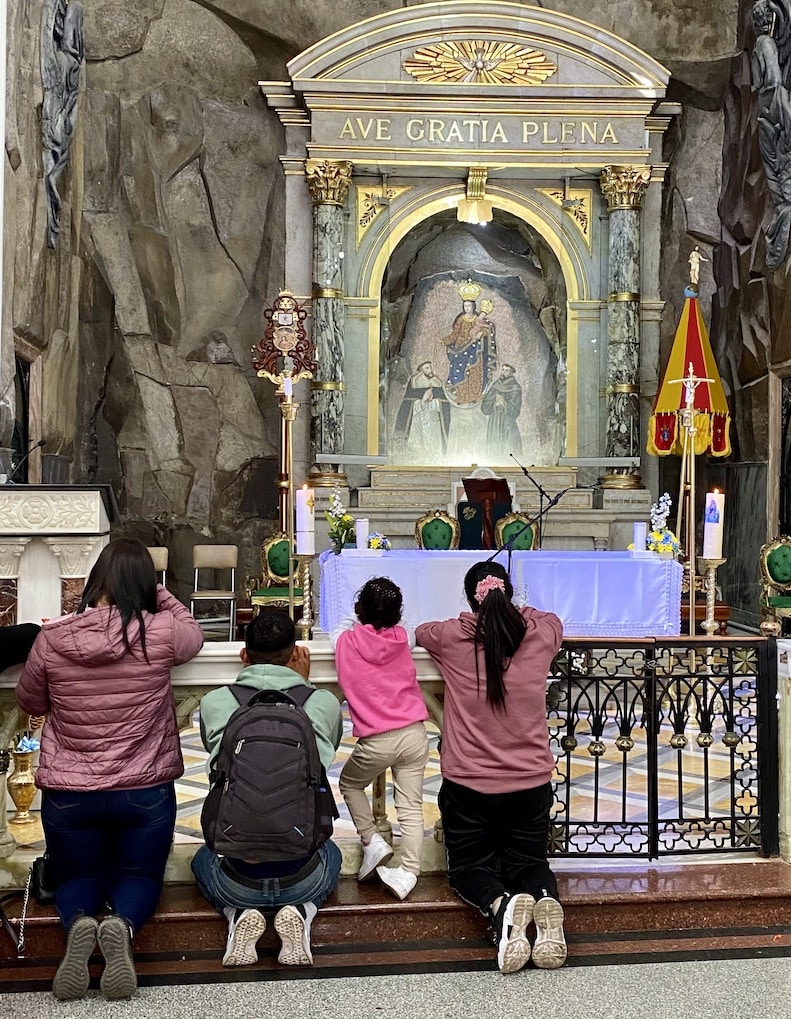
Pilgrims pray in front of Our Lady of Las Lajas, which remains in pristine condition despite the passing of time and projects a glow that seems to come from within. Photo by Teresa Bergen
The department of Nariño is named after Antonio Nariño, who briefly served as Bolivar’s vice president in 1821. His statue stands in the middle of Pasto’s town square, a taunting affront to Pastusos whose forebears were butchered on Black Christmas. Locals probably rejoice every time a pigeon lands and relieves itself on the statue’s head.
Modern Pasto businesses
While much of Pasto looked old and rather worn, some modern businesses surprised me, especially the incredible Hotel V1501. This artsy hotel named for the geological code given to Galeras, the nearby volcano, opened last December. It combines indigenous motifs with bright geometric designs. The lobby is a happy looking place, with an enormous bright beaded tapestry hanging behind the reception desk, basket chairs and a green living wall of plants. In the common space on the second floor, step back from a wall covered with colored plates and you’ll see they form the face of the endangered Colombian spectacled bear. Huge neon outlines of fish swim across the ceiling of the busy upstairs café. I met hotel designer Ana Maria Chaves, who herself looks like a work of art. “We got inspired by the nature from our region,” she explained.
For dinner at Migrante, our big group and one other couple were the only people eating. Juan Ruano worked in his father’s export business before following his dream to become a chef. He lived in Spokane, Hong Kong and Paris, then returned to his hometown of Pasto and opened Migrante in 2017. The menu features upscale treatments of indigenous ingredients, artfully plated. It struck me as a bit ahead of the local dining scene, which Ruano admitted to. “Pasto is conservative,” he said. “People like big portions of familiar food.” And they mostly eat at home, except for celebrations. During our dinner, the door was locked from the inside and guarded by police. Which made me wonder about Migrante’s viability, while hoping Ruano could live out his dream.
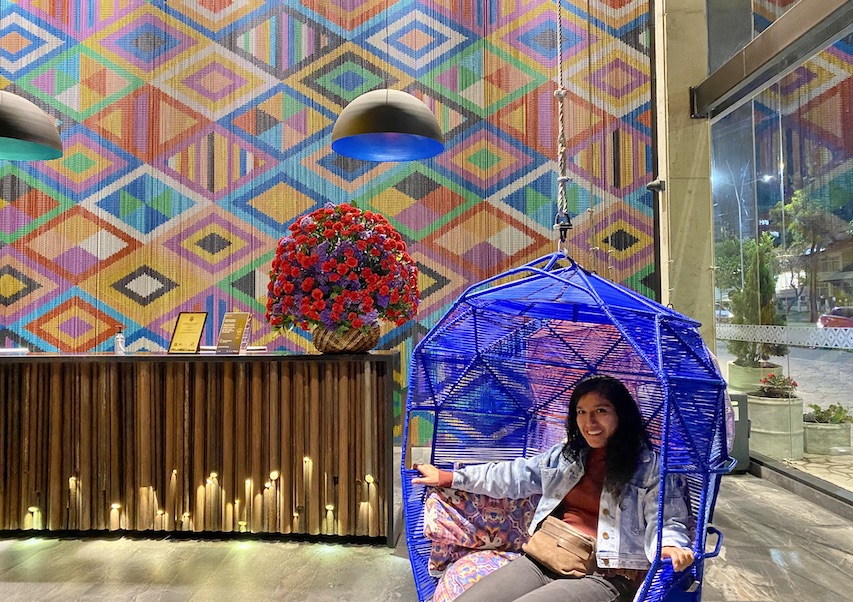
Laura Gaviria, our knowledgeable guide, who also works as a teacher and trilingual interpreter, tries out a basket chair in the lobby of Hotel V1501. Photo by Teresa Bergen
These new businesses showed young Pastusos embracing the wider world, while also demonstrating indigenous pride. Most of the people are of mixed heritage, and many, like our guide Laura, deeply feel a connection to the land and to the lives and traditions of indigenous forebears, whether or not they can trace their specific family tree.
Medical tourism in Pasto
Our last morning in Pasto took a strange turn when we learned we would be visiting a medical tourism facility. I’d heard of these but had never visited one. I was mildly curious though it wasn’t exactly my top choice of activity. But we mostly were good sports and opened our minds to learning about the plastic surgery, dentistry and other treatments available at Bellatriz.
Photographers and videographers followed our group around like we were celebrities. It was a little weird. We all joked that they’d use our likenesses as “before” pictures. The facilities were sparkling clean, and if you wanted to spend a month getting your eyelids lifted and your teeth straightened in a foreign country, Bellatriz could be a contender.
Overall, Nariño is a place of great natural beauty, with soaring mountains, volcanoes and agriculture. Combine that with its complex culture, and it’s an intriguing place for people looking for a fairly accessible but off-the-beaten-path trip to South America.![]()
EWNS contributor Teresa Bergen lives in Portland. Her previous features described America’s harvest festivals and life above the Arctic Circle.

